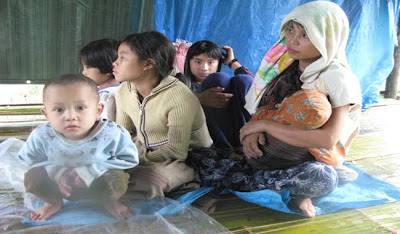On the Run
 Most of the refugees at Mae Usu temporary refugee camp are children.
Most of the refugees at Mae Usu temporary refugee camp are children.(Photo by Yeni/The Irrawaddy News)
By YENI
The Irrawaddy News
MAE USU, Thailand — "If there is peace again, we will go back to our village," says the 60-year-old Karen woman, Bi Mae, as she holds her 4-month-old grandson in her arms in a makeshift bamboo hut.
But she knows well that she may never see some members of her family again or return to her village in Karen State, which has experienced a brutal civil war for more than 60 years.
Just two weeks ago, Bi Mae and four of her grandchildren crossed into Thailand with more than 500 other Karen refugees, as gun fire echoed in the hills and news spread that the junta’s army was rounding up villagers for forced labor.
Since the beginning of June, fierce clashes between a joint force of the junta’s army and the Democratic Karen Buddhist Army (DKBA) engaged the Karen National Liberation Army (KNLA), forcing some 4,000 Karen villagers and internally displaced persons from Ler Per Her camp in Burma to flee to Tha Song Yang in Thailand’s Tak Province for safety. Many refugees are also secretly living with friends along the border, but the exact number is impossible to determine.
Refugees are living at six sites. The Irrawaddy interviewed refugees crowded into the grounds behind a Thai ecotourism site at Mae Usu cave, only a few kilometers inside the Burmese-Thai border.
"Right now 1,998 people are on the list here. Most of them are women and children,” says Chaklo, a member of the Karen Youth Organization (KYO), one of the community-based organizations helping refugees.
To help support the refugees, the Thai Burma Border Consortium (TBBC), an alliance of NGOs working for humanitarian relief, has distributed rice, beans, fish paste and salt, while the French NGO, Solidarit?s, provided water and sanitary facilities. The UNHCR has provided plastic sheets and tarpaulins for the shelter.
However, torrential rains have been falling for many days, making life even more difficult. At the camp’s makeshift clinic—supported by Dr. Cynthia Maung, and her Backpack Health Workers Team—many patients receive treatment for serious gastrointestinal problems like diarrhea and dysentery that are common ailments in the rainy season. Children in the camp are particularly at risk, according to the medics. Some children sleep in the bamboo huts while others play on the muddy ground of the green fields.
"They need to learn,” said Chaklo. “We also are ready to do that. But the Thai authorities don’t want us to set up a school here because the site is temporary."
Traditionally, the Thai policy is to start out with a short-term solution to aid new Karen refugees. While there is fighting on Burmese soil, the authorities grant the civilians permission to cross the border. But if there is no fighting, the refugees will be sent back to Burma. Presently, there have been no further reports of fighting after the withdrawal of KNLA troops from their military bases.
But there are ongoing reports of abuses by DKBA forces—forced recruitment, forced labor and money/food/livestock extortion—causing more people to flee and cross into Thailand. As a result, the refugees, for now, have been allowed to remain.
On July 9, Tassana Vichaithanapat, the director of the Foreign Affairs Division of the Operations Centre for Displaced Persons in the Ministry of Interior, visited one of the new sites, Nuh Bo.
During his visit, he met with refugee representatives, Thai district-level authorities and military officials and urged the authorities and international agencies to continue to provide humanitarian support while the Thai government tries to find a durable solution or until the displaced people are able to return to their homes, according to the TBBC.
Also, the Tha Song Yang district committee, which includes military, border police and UNHCR representatives, met on July 15 to consider possible solutions: an immediate return to Burma, relocation to Mae La refugee camp, or to open a new refugee camp at the site where the refugees are currently staying.
"Finally, they agreed that the refugees should stay where they are until the end of the rainy season. At that time, the security and humanitarian situation will be reviewed again to determine the next steps," said Angelina Sakic, a TBBC Program coordinator. "But the most likely outcome is that if the situation has not improved, they will be moved to Mae La camp."
In the meantime, most refugees hope to return to their village as soon as possible. Many are traumatized, thinking of their crops and the livestock they left behind and how it could all be destroyed or confiscated by the junta’s soldiers or DKBA troops.
Some men have left their family in the camp and crossed back to their village to determine if their possessions are intact. Their lives are at risk because Burmese soldiers and DKBA troops control the area.
"If they see them, they will shoot,” says Chaklo. “They think maybe they are KNLA men burying landmines. We hear the sound of gun fire everyday."










